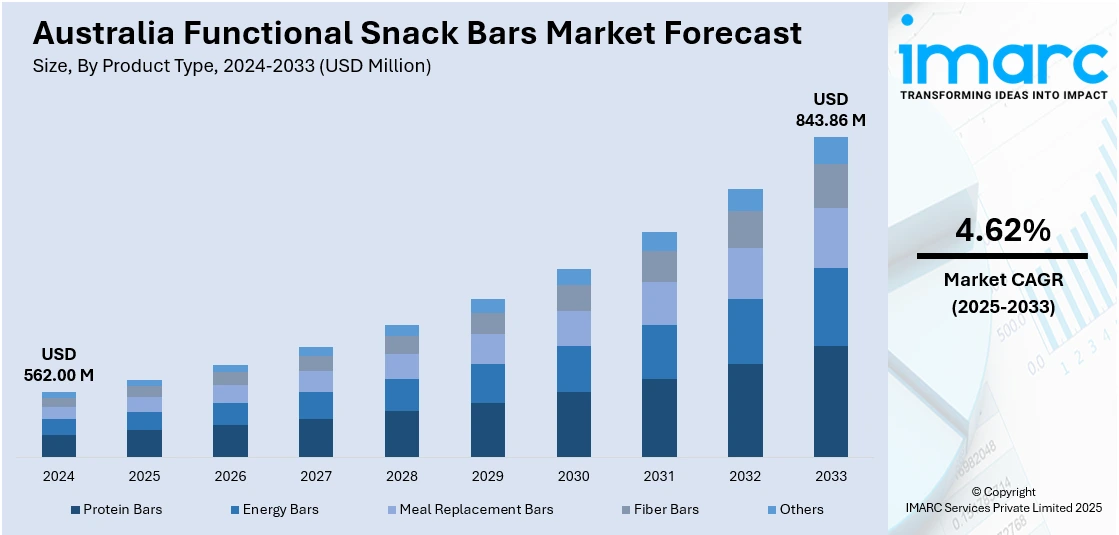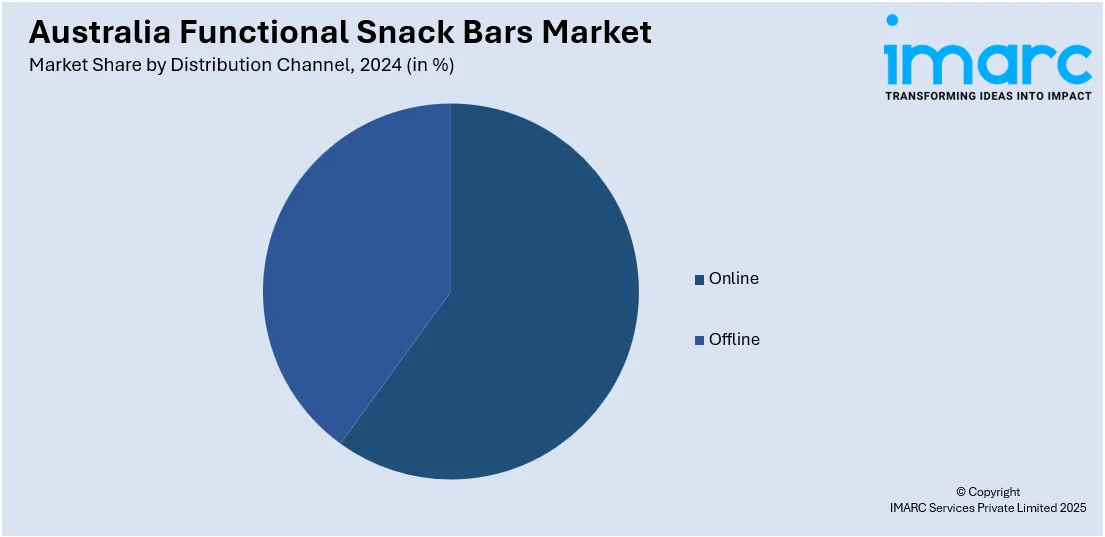
Australia Functional Snack Bars Market Size, Share, Trends and Forecast by Product Type, Ingredient Type, Distribution Channel, Price Range, Consumer Group, and Region, 2025-2033
Australia Functional Snack Bars Market Overview:
The Australia functional snack bars Market size reached USD 562.00 Million in 2024. Looking forward, IMARC Group expects the market to reach USD 843.86 Million by 2033, exhibiting a growth rate (CAGR) of 4.62% during 2025-2033. The market is driven by the rising health consciousness, busier lifestyles, and a growing preference for convenient yet nutritious foods. Consumers are seeking snacks that align with wellness goals such as improved digestion, energy, or immunity. The popularity of clean-label, plant-based, and allergen-free options is also propelling Australia functional snack bars market share. Additionally, digital retail channels and social media marketing are expanding product accessibility and awareness, allowing brands to engage directly with health-focused, on-the-go consumers across various demographics.
|
Report Attribute
|
Key Statistics
|
|---|---|
|
Base Year
|
2024
|
|
Forecast Years
|
2025-2033
|
|
Historical Years
|
2019-2024
|
| Market Size in 2024 | USD 562.00 Million |
| Market Forecast in 2033 | USD 843.86 Million |
| Market Growth Rate 2025-2033 | 4.62% |
Australia Functional Snack Bars Market Trends:
Rise of Plant-Based and Vegan Snack Bars
A growing number of Australians are adopting plant-based lifestyles, and this is clearly reflected in their snacking choices. Consumers are increasingly opting for snack bars made without animal products, driven by concerns around health, sustainability, and animal welfare. Brands are responding by creating bars using ingredients like nuts, seeds, grains, and plant-based proteins. These products appeal not only to vegans but also to those who are looking to reduce their intake of dairy or meat. The demand for natural, clean-label snacks is also influencing this trend, with people avoiding artificial additives and preferring bars that offer wholesome, minimally processed ingredients. This movement aligns with broader lifestyle shifts where convenience, ethics, and wellness go hand in hand, making plant-based snack bars an attractive and growing category in the market further impelling the Australia functional snack bars market growth.

To get more information on this market, Request Sample
The Shift to Functional Snacking
Australians are getting more health-conscious, which is transforming the way they snack. According to FSANZ's 2023 Consumer Insights Tracker, 66% of Australians place a higher value on nutrition than convenience, and 73% of them actively work to maintain a healthy diet. This demand is propelling sales of functional snack bars that do more than just deliver energy. Consumers are looking for more benefits such as better digestion, immunity, and mental clarity. To satisfy these demands, brands are fortifying bars with functional elements like probiotics, adaptogens, herbs, and superfoods. Such ingredients tend to be marketed based on specific wellness objectives such as stress relief or beauty support. The attraction is in the convenience foods that are both portable and health-promoting. This is part of a wider trend in which food is no longer merely energy, but a means of self-care and health, paralleling the concerns of contemporary, health-oriented Australians.
Growth of Online Retail and Direct-to-Consumer Channels
Australians are changing the way they buy snacks, and many are opting for online channels for convenience and choice. Functional snack bar brands are taking advantage of this trend by making their products available on e-commerce sites, subscription boxes, and social marketplace sites. These platforms enable customers to sample new brands and flavors not found in stores. Online shopping also allows brands to connect more intimately with consumers, tailor offerings, and react in a timely manner to consumer input. Direct-to-consumer (D2C) business models provide companies with more control over their messaging and customer experience, tending to result in more innovative and reactive product development. With consumers increasingly seeking convenience and customized solutions, the online space becomes an integral aspect of how functional snack bars are discovered, bought, and consumed in the Australian market.
Australia Functional Snack Bars Market Segmentation:
IMARC Group provides an analysis of the key trends in each segment of the market, along with forecasts at the country and regional levels for 2025-2033. Our report has categorized the market based on product type, ingredient type, distribution channel, price range, and consumer group.
Product Type Insights:
- Protein Bars
- Energy Bars
- Meal Replacement Bars
- Fiber Bars
- Others
A detailed breakup and analysis of the market based on the product type have also been provided in the report. This includes protein bars, energy bars, meal replacement bars, fiber bars, and others.
Ingredients Type Insights:
- Nuts and Seeds
- Grains and Cereals
- Fruits and Vegetables
- Dairy-Based Ingredients
- Others
The report has provided a detailed breakup and analysis of the market based on the ingredient type. This includes nuts and seeds, grains and cereals, fruits and vegetables, dairy-based ingredients, and others.
Distribution Channel Insights:

- Online
- Offline
A detailed breakup and analysis of the market based on the distribution channel have also been provided in the report. This includes online, and offline.
Price Range Insights:
- Premium
- Mid-Range
- Economy
The report has provided a detailed breakup and analysis of the market based on the price range. This includes premium, mid-range, and economy.
Consumer Group Insights:
- Athletes and Fitness Enthusiasts
- Children and Teens
- Elderly Population
A detailed breakup and analysis of the market based on the consumer group have also been provided in the report. This includes athletes and fitness enthusiasts, children and teens, and elderly population.
Regional Insights:
- Australia Capital Territory & New South Wales
- Victoria & Tasmania
- Queensland
- Northern Territory & Southern Australia
- Western Australia
The report has also provided a comprehensive analysis of all the major regional markets, which include Australia Capital Territory & New South Wales, Victoria & Tasmania, Queensland, Northern Territory & Southern Australia, and Western Australia.
Competitive Landscape:
The market research report has also provided a comprehensive analysis of the competitive landscape. Competitive analysis such as market structure, key player positioning, top winning strategies, competitive dashboard, and company evaluation quadrant has been covered in the report. Also, detailed profiles of all major companies have been provided.
Australia Functional Snack Bars Market News:
- In November 2024, FULFIL Vitamin & Protein Bars, a UK favorite, launched in Australia, offering a smart, tasty snack for busy lifestyles. Available in indulgent flavours like Chocolate Peanut Butter and Salted Caramel, each bar is packed with protein, nine essential vitamins, and low sugar. Designed for gym-goers, workers, and adventurers alike, FULFIL delivers bold taste without compromise—perfect for Aussies wanting convenient, nutritious snacks that fit effortlessly into their day.
Australia Functional Snack Bars Market Report Coverage:
| Report Features | Details |
|---|---|
| Base Year of the Analysis | 2024 |
| Historical Period | 2019-2024 |
| Forecast Period | 2025-2033 |
| Units | Million USD |
| Scope of the Report |
Exploration of Historical Trends and Market Outlook, Industry Catalysts and Challenges, Segment-Wise Historical and Future Market Assessment:
|
| Product Types Covered | Protein Bars, Energy Bars, Meal Replacement Bars, Fiber Bars, Others |
| Ingredient Types Covered | Nuts and Seeds, Grains And Cereals, Fruits and Vegetables, Dairy-Based Ingredients, Others |
| Distribution Channels Covered | Online, Offline |
| Prices Ranges Covered | Premium, Mid-Range, Economy |
| Consumer Groups Covered | Athletes and Fitness Enthusiasts, Children and Teens, Elderly Population |
| Regions Covered | Australia Capital Territory & New South Wales, Victoria & Tasmania, Queensland, Northern Territory & Southern Australia, Western Australia |
| Customization Scope | 10% Free Customization |
| Post-Sale Analyst Support | 10-12 Weeks |
| Delivery Format | PDF and Excel through Email (We can also provide the editable version of the report in PPT/Word format on special request) |
Key Questions Answered in This Report:
- How has the Australia functional snack bars market performed so far and how will it perform in the coming years?
- What is the breakup of the Australia functional snack bars market on the basis of product type?
- What is the breakup of the Australia functional snack bars market on the basis of ingredient type?
- What is the breakup of the Australia functional snack bars market on the basis of distribution channel?
- What is the breakup of the Australia functional snack bars market on the basis of price range?
- What is the breakup of the Australia functional snack bars market on the basis of consumer group?
- What is the breakup of the Australia functional snack bars market on the basis of region?
- What are the various stages in the value chain of the Australia functional snack bars market?
- What are the key driving factors and challenges in the Australia functional snack bars market?
- What is the structure of the Australia functional snack bars market and who are the key players?
- What is the degree of competition in the Australia functional snack bars market?
Key Benefits for Stakeholders:
- IMARC’s industry report offers a comprehensive quantitative analysis of various market segments, historical and current market trends, market forecasts, and dynamics of the Australia functional snack bars market from 2019-2033.
- The research report provides the latest information on the market drivers, challenges, and opportunities in the Australia functional snack bars market.
- Porter's five forces analysis assist stakeholders in assessing the impact of new entrants, competitive rivalry, supplier power, buyer power, and the threat of substitution. It helps stakeholders to analyze the level of competition within the Australia functional snack bars industry and its attractiveness.
- Competitive landscape allows stakeholders to understand their competitive environment and provides an insight into the current positions of key players in the market.
Need more help?
- Speak to our experienced analysts for insights on the current market scenarios.
- Include additional segments and countries to customize the report as per your requirement.
- Gain an unparalleled competitive advantage in your domain by understanding how to utilize the report and positively impacting your operations and revenue.
- For further assistance, please connect with our analysts.
 Request Customization
Request Customization
 Speak to an Analyst
Speak to an Analyst
 Request Brochure
Request Brochure
 Inquire Before Buying
Inquire Before Buying




.webp)




.webp)












